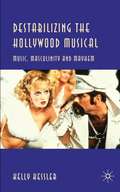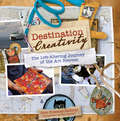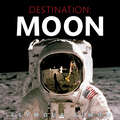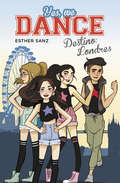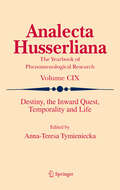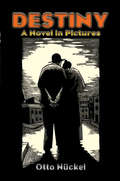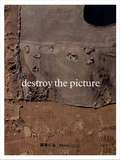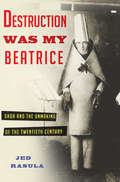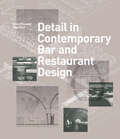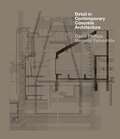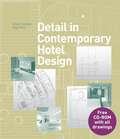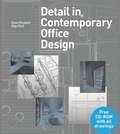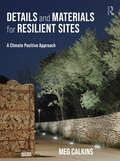- Table View
- List View
Destabilizing the Hollywood Musical
by Kelly KesslerA critical survey of Hollywood film musicals from the 1960s to the present. This book examines how, in the post-studio system era, cultural, industrial and stylistic circumstances transformed this once happy-go-lucky genre into one both fluid and cynical enough to embrace the likes of Rocky Horror and pave the way for Cannibal! and Moulin Rouge!.
Destination Creativity: The Life-Altering Journey of the Art Retreat
by Tonia Davenport Rice Freeman-ZacheryExperience art retreats without leaving your home!There's a community of passionate, creative souls looking to connect, and the art retreat is where is happens. In Destination Creativity, Ricë Freeman-Zachery brings the life-altering journey of the art retreat from venues all across the country straight into your hands and the comfort of your favorite chair. Maybe you've heard about the many different places you can go to take art workshops from a variety of talented artistic instructors, but you haven't been sure which retreat experience is right for you. Ricë has done your homework! From Port Townsend, Washington's Artfest to Hampton, Virginia's Art & Soul, from rural Wisconsin to the strip of Las Vegas, from beads to quilts to painting with your hands, she has the inside scoop for you in Destination Creativity and a first-hand account of nine inspiring art retreats.· Take five workshops right alongside Ricë with step-by-step instruction and a glimpse into the actual classroom experience.· Hear from a variety of attendees--creative types just like you--what it is that drew them to attend their chosen event and be inspired by their life-changing stories.· See what the retreats actually look like with plenty of atmospheric photos taken by Ricë's favorite sidekick, Earl Zachery.· Discover ideas for hosting creative get-togethers in your own hometown including naming your retreat, picking a venue and planning meals.Destination Creativity is your chance to see what all of the buzz is about. Pull up a chair and take the journey.www.CreateMixedMedia.comThe online community for mixed-media artists
Destination London: German-Speaking Emigrés and British Cinema, 1925-1950 (Film Europa #6)
by Christian Cargnelli Tim BergfelderThe legacy of emigrés in the British film industry, from the silent film era until after the Second World War, has been largely neglected in the scholarly literature. Destination London is the first book to redress this imbalance. Focusing on areas such as exile, genre, technological transfer, professional training and education, cross-cultural exchange and representation, it begins by mapping the reasons for this neglect before examining the contributions made to British cinema by emigré directors, actors, screenwriters, cinematographers, set designers, and composers. It goes on to assess the cultural and economic contexts of transnational industry collaborations in the 1920s, artistic cosmopolitanism in the 1930s, and anti-Nazi propaganda in the 1940s.
Destination: Moon
by Seymour SimonAn out-of-this-world exploration of the 1969 Moon landing from children’s science expert Seymour Simon! This nonfiction picture book is an excellent choice to share during homeschooling, in particular for children ages 6 to 8. It’s a fun way to learn to read and as a supplement for activity books for children.In July of 1969, NASA sent the Apollo 11 spacecraft to the Moon. Inside were three people: Neil Armstrong, Buzz Aldrin, and Michael Collins. They went into lunar orbit a few days later. More than a hundred hours after launch, the word came back: “The Eagle has landed!”In this exciting account of the famous 1969 Moon landing, award-winning science writer Seymour Simon tells the story of the Space Race between the US and the Soviet Union; recalls how families across the world sat captivated in front of their TVs to witness humankind’s first steps beyond Earth; and explains much of the science and technology that got our astronauts to the Moon on that remarkable day.Perfect for young scholars’ school reports, Destination: Moon features clear text, vibrantly colored pages, engaging sidebars, and stunning full-color photographs. This book includes an author's note, a glossary, a timeline, and an index and supports the Common Core State Standards.
Destino: Londres (Serie Yes, we dance #Volumen 2)
by Esther Sanz¡Acompaña a Martina, Sofía, Liu y Violeta en esta nueva aventura en el corazón de Londres! Martina y sus amigas viajan hasta la capital inglesa para participar en el maratón de baile que va a celebrarse en el Hyde Park. El grupo que salga ganador de esta competición será el que aparecerá en el nuevo videoclip del grupo del momento, los BB Brothers. No será nada fácil, pero las chicas lo tienen claro... ¡Están dispuestas a darlo todo!
Destiny, the Inward Quest, Temporality and Life
by Anna-Teresa Tymieniecka"There is no greater gift to man than to understand nothing of his fate", declares poet-philosopher Paul Valery. And yet the searching human being seeks ceaselessly to disentangle the networks of experiences, desires, inward promptings, personal ambitions, and elevated strivings which directed his/her life-course within changing circumstances in order to discover his sense of life. Literature seeks in numerous channels of insight the dominant threads of "the sense of life", "the inward quest", "the frames of experience" in reaching the inward sources of what we call 'destiny' inspired by experience and temporality which carry it on. This unusual collection reveals the deeper generative elements which form sense of life stretching between destiny and doom. They escape attention in their metamorphic transformations of the inexorable, irreversibility of time which undergoes different interpretations in the phases examining our life. Our key to life has to be ever discovered anew.
Destiny: A Novel in Pictures (Dover Fine Art, History Of Art Series)
by Otto NückelIn an arresting series of images, the story of a young woman's tragic, often violent, life unfolds. Follow her as she lives out her destiny through seventeen chapters, including Childhood, The Father, The Mother, Service, Love, Vengeance, The Seducer, and The Crime. Each visual dimension of her world is a riveting discovery.In the style of genre masters Frans Masereel and Lynd Ward, Nückel's graphic novel pulses with movement and a vivid unspoken life. No words are needed to accompany the 188 stark black-and-white illustrations: the pictures speak for themselves. This stunning pictorial narrative, open to endless interpretation, is charged with a page-turning power by each memorable and hypnotic drawing. <P><P> <i>Advisory: Bookshare has learned that this book offers only partial accessibility. We have kept it in the collection because it is useful for some of our members. Benetech is actively working on projects to improve accessibility issues such as these.</i>
Destiny: The Exotic Collection, Volume One
by Insight EditionsDiscover all of the Exotic weapons from the world of Destiny 2 in this comprehensive visual guide, loaded with stunning artwork!From the Thorn and Hawkmoon hand cannon, to the Outbreak Perfected rifle, Destiny 2 features an incredible arsenal of exotic weaponry. Now, fans of the hit series can experience these weapons like never before, with this definitive guide to the exotic weapons of Destiny 2. Featuring magnificent art from Destiny 2, it is the ultimate book on the most unique weapons in Destiny 2. BEAUTIFUL EXOTIC WEAPON ARTWORK: From the Thorn and Hawkmoon hand cannon, to the Outbreak Perfected rifle, this book features the beautiful art of Destiny 2. The incredible detail of the illustrations featured in this book will give fans an unparalleled experience of the entire Destiny 2 exotic weapon arsenal. OWN THE DEFINITIVE DESTINY 2 EXOTIC WEAPONS GUIDE: This book will be the ultimate word on the exotic weapons of Destiny 2. COMPLETE YOUR DESTINY LIBRARY: Destiny: The Exotic Collection, Volume One stands alongside fan-favorite books such as Destiny: The Official Cookbook and Art of Destiny Volume One and Two.
Destroy The Picture
by Paul Schimmel<P>The first book to take a transnational view of destruction in abstract painting of the postwar period. Painting the Void: 1949–1962 focuses on one of the most significant consequences of the rise of gestural abstraction in twentieth-century painting: artists' literal assault on the picture plane. <P>Responding to the social and political climate of the postwar period—especially the crisis of humanity resulting from the atomic bomb—international artists ripped, cut, burned, or affixed objects to the traditionally two-dimensional canvas. <P>The exhibition and accompanying catalogue mark the first time that these strategies have been considered together as a coherent mode of artistic production, expanding the scholarship on this critical moment in history. <P>Artists featured in the exhibition include very well-known figures as well as more obscure ones, though no less important, such as Robert Rauschenberg, Lee Bontecou, Yves Klein, Niki de Saint Phalle, Alberto Burri, Lucio Fontana, Salvatore Scarpitta, Antoni Tàpies, and Kazuo Shiraga, as well as Jean Fautrier, Raymond Hains, John Latham, Otto Müehl, Jacques Villeglé, and Shozo Shimamoto.
Destroyed—Disappeared—Lost—Never Were (ICMA Books | Viewpoints)
by Beate Fricke and Aden KumlerTo write about works that cannot be sensually perceived involves considerable strain. Absent the object, art historians must stretch their methods to, or even past, the breaking point. This concise volume addresses the problems inherent in studying medieval works of art, artifacts, and monuments that have disappeared, have been destroyed, or perhaps never existed in the first place.The contributors to this volume are confronted with the full expanse of what they cannot see, handle, or know. Connecting object histories, the anthropology of images, and historiography, they seek to understand how people have made sense of the past by examining objects, images, and architectural and urban spaces. Intersecting these approaches is a deep current of reflection upon the theorization of historical analysis and the ways in which the past is inscribed into layers of evidence that are only ever revealed in the historian’s present tense.Highly original and theoretically sophisticated, this volume will stimulate debate among art historians about the critical practices used to confront the formative presence of destruction, loss, obscurity, and existential uncertainty within the history of art and the study of historical material and visual cultures.In addition to the editors, the contributors to this volume are Michele Bacci, Claudia Brittenham, Sonja Drimmer, Jaś Elsner, Peter Geimer, Danielle B. Joyner, Kristopher W. Kersey, Lena Liepe, Meekyung MacMurdie, and Michelle McCoy.
Destruction Was My Beatrice: Dada and the Unmaking of the Twentieth Century
by Jed RasulaIn 1916, as World War I raged around them, a group of bohemians gathered at a small nightclub in Zurich, Switzerland for a series of bizarre performances. Three readers simultaneously recited a poem in three languages; a monocle-wearing teenager performed a spell from New Zealand; another young man flung bits of papier-mâché into the air and glued them into place where they landed. One of these artists called the sessions "both buffoonery and a requiem mass. ” Soon they would be known by a more evocative name: Dada. In Destruction Was My Beatrice, modernist scholar Jed Rasula presents the first narrative history of the emergence, decline, and legacy of Dada, showing how this strange artistic phenomenon spread across Europe and then the world in the wake of the Great War, fundamentally reshaping modern culture in ways we’re still struggling to understand today.
Destructive Sublime: World War II in American Film and Media (War Culture)
by Tanine AllisonThe American popular imagination has long portrayed World War II as the “good war,” fought by the “greatest generation” for the sake of freedom and democracy. Yet, combat films and other war media complicate this conventional view by indulging in explosive displays of spectacular violence. Combat sequences, Tanine Allison argues, construct a counter-narrative of World War II by reminding viewers of the war’s harsh brutality.Destructive Sublime traces a new aesthetic history of the World War II combat genre by looking back at it through the lens of contemporary video games like Call of Duty. Allison locates some of video games’ glorification of violence, disruptive audiovisual style, and bodily sensation in even the most canonical and seemingly conservative films of the genre. In a series of case studies spanning more than seventy years—from wartime documentaries like The Battle of San Pietro to fictional reenactments like The Longest Day and Saving Private Ryan to combat video games like Medal of Honor—this book reveals how the genre’s aesthetic forms reflect (and influence) how American culture conceives of war, nation, and representation itself.
Detached America: Building Houses in Postwar Suburbia (Midcentury: Architecture, Landscape, Urbanism, and Design)
by James A. JacobsDuring the quarter century between 1945 and 1970, Americans crafted a new manner of living that shaped and reshaped how residential builders designed and marketed millions of detached single-family suburban houses. The modest two- and three-bedroom houses built immediately following the war gave way to larger and more sophisticated houses shaped by casual living, which stressed a family's easy sociability and material comfort and were a major element in the cohesion of a greatly expanded middle class. These dwellings became the basic building blocks of explosive suburban growth during the postwar period, luring families to the metropolitan periphery from both crowded urban centers and the rural hinterlands. Detached America is the first book with a national scope to explore the design and marketing of postwar houses. James A. Jacobs shows how these houses physically document national trends in domestic space and record a remarkably uniform spatial evolution that can be traced throughout the country. Favorable government policies, along with such widely available print media as trade journals, home design magazines, and newspapers, permitted builders to establish a strong national presence and to make a more standardized product available to prospective buyers everywhere. This vast and long-lived collaboration between government and business--fueled by millions of homeowners--established the financial mechanisms, consumer framework, domestic ideologies, and architectural precedents that permanently altered the geographic and demographic landscape of the nation.
Detail in Contemporary Bar and Restaurant Design
by Drew PlunkettBars and restaurants need to be assertive. Customers tend not to visit them to satisfy basic appetites for food or drink but for the social opportunities. Their interiors need to occupy the imagination of their customers and to whet the appetite for a return visit. The design that gets the formula right will do as much to prolong the life of the business as the products on offer.As this book demonstrates, the conventions and mechanics of eating and drinking influence how bars and restaurants are conceived in different regions of the world. Whatever the final result users are in sustained, intimate contact with the elements of the space they inhabit and detailing must be refined enough, and visually rich enough, to withstand prolonged scrutiny. This book includes a wide range of international projects and for each one there is a descriptive text, colour photographs, floor plans, sections and construction and decorative details. A bonus CD-ROM contains all the drawings as printed in the book, in both EPS and DWG (generic CAD) formats.
Detail in Contemporary Bar and Restaurant Design (Detailing for Interior Design)
by Drew Plunkett Olga ReidBars and restaurants need to be assertive. Customers tend not to visit them to satisfy basic appetites for food or drink but for the social opportunities. Their interiors need to occupy the imagination of their customers and to whet the appetite for a return visit. The design that gets the formula right will do as much to prolong the life of the business as the products on offer.As this book demonstrates, the conventions and mechanics of eating and drinking influence how bars and restaurants are conceived in different regions of the world. Whatever the final result users are in sustained, intimate contact with the elements of the space they inhabit and detailing must be refined enough, and visually rich enough, to withstand prolonged scrutiny. This book includes a wide range of international projects and for each one there is a descriptive text, colour photographs, floor plans, sections and construction and decorative details. A bonus CD-ROM contains all the drawings as printed in the book, in both EPS and DWG (generic CAD) formats.
Detail in Contemporary Concrete Architecture
by David PhillipsDetail in Contemporary Concrete Architecture provides analysis of both the technical and the aesthetic importance of details in modern concrete architecture. Featuring the work of renowned architects from around the world, this book presents 49 of the most recently completed and influential concrete designs for both residential and commercial architecture.The projects are presented in clear and concise layouts over four pages. All of the drawings are styled consistently and presented at standard architectural scales to allow for easy comparison. Each project is presented with colour photographs, site plans and sections and elevations, as well as numerous construction details. There is also descriptive text, detailed captions and in-depth information for each project. A bonus CD-ROM contains drawings from the book, in both EPS and DWG (generic CAD) formats.
Detail in Contemporary Concrete Architecture (Detail)
by David Phillips Megumi YamashitaDetail in Contemporary Concrete Architecture provides analysis of both the technical and the aesthetic importance of details in modern concrete architecture. Featuring the work of renowned architects from around the world, this book presents 49 of the most recently completed and influential concrete designs for both residential and commercial architecture.The projects are presented in clear and concise layouts over four pages. All of the drawings are styled consistently and presented at standard architectural scales to allow for easy comparison. Each project is presented with colour photographs, site plans and sections and elevations, as well as numerous construction details. There is also descriptive text, detailed captions and in-depth information for each project. A bonus CD-ROM contains drawings from the book, in both EPS and DWG (generic CAD) formats.
Detail in Contemporary Hotel Design
by Drew PlunkettHotel interiors need to satisfy the imaginations of their customers and whet the appetite for a return visit or recommendation, and the design that gets the formula right will do as much to prolong the life of the business as the service delivered within the hotel. This book explores in detail 36 of the best recent hotel interior design schemes, featuring projects by leading architects from around the world. The book is divided into three sections embracing newly built and refurbished hotels as well as conversions.Each project includes photographs as well as detailed drawings and plans, where appropriate, as well as informative text describing the design concept and process. A bonus CD contains drawings featured in the book, in both eps and dwg (generic CAD) formats.
Detail in Contemporary Hotel Design (Detailing for Interior Design)
by Drew Plunkett Olga ReidHotel interiors need to satisfy the imaginations of their customers and whet the appetite for a return visit or recommendation, and the design that gets the formula right will do as much to prolong the life of the business as the service delivered within the hotel. This book explores in detail 36 of the best recent hotel interior design schemes, featuring projects by leading architects from around the world. The book is divided into three sections embracing newly built and refurbished hotels as well as conversions.Each project includes photographs as well as detailed drawings and plans, where appropriate, as well as informative text describing the design concept and process. A bonus CD contains drawings featured in the book, in both eps and dwg (generic CAD) formats.
Detail in Contemporary Office Design
by Drew PlunkettOffice design has changed significantly over the last few years and is now one of the most innovative areas of interior design. It used to be the case that only the public spaces of an office were creatively designed, but increasingly the staff areas are seen as key reflections of the company brand as well. In more radical offices, there is also a growing belief in the importance of work areas as social spaces and a blurring of the distinction between work and recreation.This book explores in detail 42 of the best recent office design schemes, featuring projects from leading architects around the world. Each project includes photographs as well as detailed drawings and plans, where appropriate, in addition to informative text describing the design concept and process. A bonus CD contains drawings featured in the book, in both eps and dwg (generic CAD) formats.
Detail in Contemporary Office Design (Detailing for Interior Design)
by Drew Plunkett Olga ReidOffice design has changed significantly over the last few years and is now one of the most innovative areas of interior design. It used to be the case that only the public spaces of an office were creatively designed, but increasingly the staff areas are seen as key reflections of the company brand as well. In more radical offices, there is also a growing belief in the importance of work areas as social spaces and a blurring of the distinction between work and recreation.This book explores in detail 42 of the best recent office design schemes, featuring projects from leading architects around the world. Each project includes photographs as well as detailed drawings and plans, where appropriate, in addition to informative text describing the design concept and process. A bonus CD contains drawings featured in the book, in both eps and dwg (generic CAD) formats.
Detailing for Acoustics
by Peter Lord Duncan TempletonA manual of constructional details which shows how successful results in acoustic design can be achieved by correct use of building materials, products and components. Details are drawn to scale and carry informative labelling and supplementary text. This updated and revised edition of an established reference book, in an improved format and layout, will be a welcome addition to current reference works on acoustic design.
Details and Materials for Resilient Sites: A Climate Positive Approach
by Meg CalkinsProviding comprehensive information for closing material loops and reducing carbon impacts of site construction, this ground-breaking book is an essential resource for landscape architects and engineers to meet the environmental challenges of the 21st century.It provides strategies, tools, and detailed information for the practice of climate positive design. Reduced carbon, resource efficient materials, and material mixes are addressed for both standard and alternative materials including stone, concrete, asphalt pavement, brick, earth-based materials, wood, biobased materials, metals, and plastics. Construction considerations are discussed and illustrated, and strategies to reduce environmental impacts are offered. Emphasis is placed on durable, resource efficient structures, and reduced embodied carbon approaches for pavements, porous pavements, green roofs, bioengineered embankments, retaining walls freestanding walls, decks and boardwalks, and rails, fences, and screens. Exemplary case studies from around the world are highlighted, and key resources such as assessment tools, information transparency tools, and benchmarking measures are provided.Responding to the need for landscape architecture to account for climate change, resource consumption, and habitat destruction, this important book is key reading for both professionals and students alike.
Details from a Larger Canvas
by Helen McleanThe biggest surprise - and disappointment - that life holds is that it is over so fast. The golden tomorrow, to which most people (usually women) put off their hopes rarely appears. This is the lesson learned by Helen McLean in her memoir. Details from a Larger Canvas is about a woman with the expectations of her time and class heavy upon her shoulders; in short, she is supposed to be much the same woman as her Rosedale matron mother-in-law whose life was bound up in sets of rules and whose life had little expression except in the form of materialistic acquisition and censure. Instead, Helen creates her own life - and, while painting a portrait of Margaret Laurence, finds a woman with whom she has common ground.
Detecting Trust and Deception in Group Interaction (Terrorism, Security, and Computation)
by V. S. Subrahmanian Judee K. Burgoon Norah E. DunbarThis book analyzes the multimodal verbal and nonverbal behavior of humans in both an artificial game, based on the well-known Mafia and Resistance games, as well as selected other settings. This book develops statistical results linking different types of facial expressions (e.g. smile, pursed lips, raised eyebrows), vocal features (e.g., pitch, loudness) and linguistic features (e.g., dominant language, turn length) with both unary behaviors (e.g. is person X lying?) to binary behaviors (Is person X dominant compared to person Y? Does X trust Y? Does X like Y?). In addition, this book describes machine learning and computer vision-based algorithms that can be used to predict deception, as well as the visual focus of attention of people during discussions that can be linked to many binary behaviors. It is written by a multidisciplinary team of both social scientists and computer scientists.Meetings are at the very heart of human activity. Whether you are involved in a business meeting or in a diplomatic negotiation, such an event has multiple actors, some cooperative and some adversarial. Some actors may be deceptive, others may have complex relationships with others in the group. This book consists of a set of 11 chapters that describe the factors that link human behavior in group settings and attitudes to facial and voice characteristics.Researchers working in social sciences (communication, psychology, cognitive science) with an interest in studying the link between human interpersonal behavior and facial/speech/linguistic characteristics will be interested in this book. Computer scientists, who are interested in developing machine learning and deep learning based models of human behavior in group settings will also be interested in purchasing this book.
